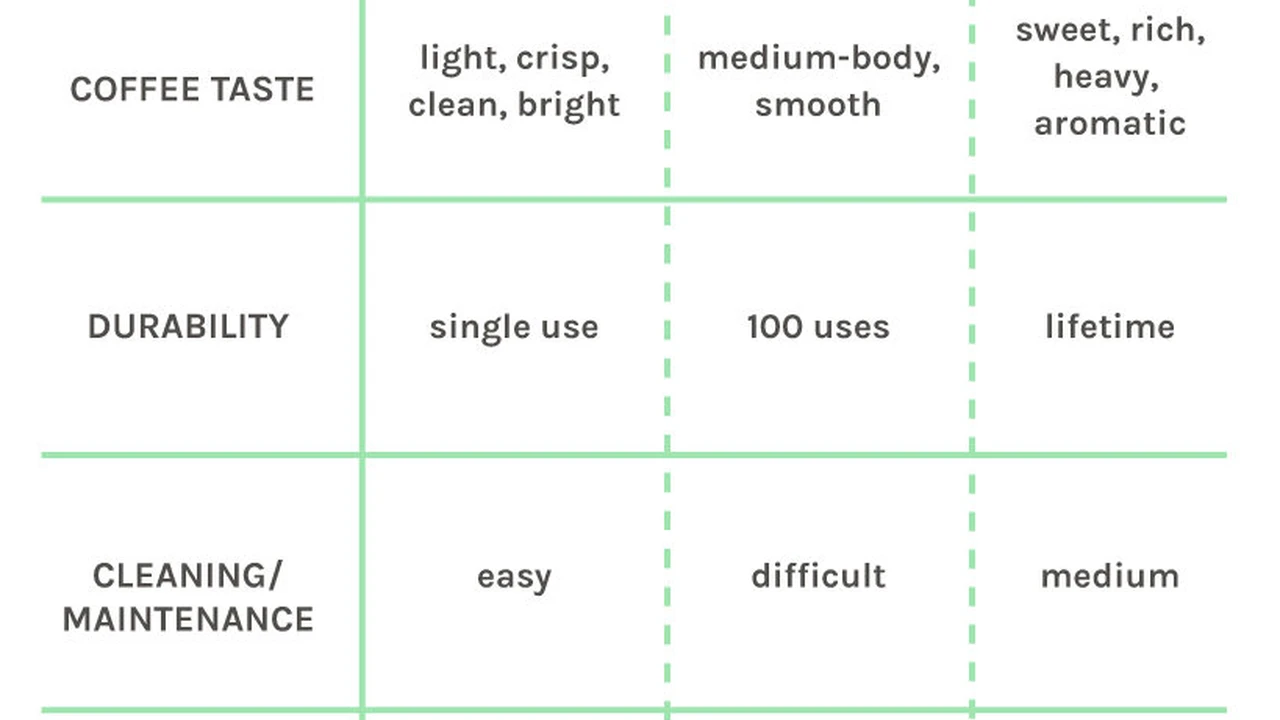Coffee Kettles: Gooseneck vs. Electric - Which is Better?
Coffee pod machines offer convenience, but how does the coffee quality compare? We weigh the pros and cons of pod machines, considering ease of use, cost, and environmental impact. Make an informed decision.

The Allure of Coffee Pods: Understanding the Convenience Factor
Let’s face it, mornings are hectic. The snooze button gets hit a few too many times, and suddenly you’re scrambling to get out the door. In this whirlwind, the appeal of a coffee pod machine is undeniable. It's the promise of a quick, consistent cup of coffee with minimal effort. No grinding beans, no measuring coffee grounds, no messy cleanup. Just pop in a pod, press a button, and boom – coffee. But is this convenience worth sacrificing the quality of your brew?
Coffee pod machines, also known as single-serve coffee makers, have revolutionized the way many people consume coffee. They’ve become a staple in offices, homes, and even hotels, offering a seemingly perfect solution for those who value speed and simplicity. However, behind the sleek designs and catchy marketing campaigns lies a more complex reality that deserves a closer examination. We'll delve into the convenience aspects, the potential compromises in coffee quality, the cost considerations, and the environmental impact of these popular devices.
Coffee Quality Under Scrutiny: Exploring the Potential Compromises
Here’s where things get a little more nuanced. While coffee pod machines excel in convenience, they often fall short when it comes to delivering the rich, complex flavors of a freshly brewed cup from whole beans. Several factors contribute to this difference:
- Stale Coffee: Coffee beans begin to lose their flavor within minutes of being ground. Pre-ground coffee in pods, even if nitrogen-flushed, will inevitably be less fresh than freshly ground beans. This staleness can result in a less aromatic and flavorful cup of coffee.
- Grind Size: The grind size is crucial for optimal coffee extraction. Pod machines typically use a standardized grind size that may not be ideal for all types of coffee. This can lead to under-extraction (sour taste) or over-extraction (bitter taste).
- Water Temperature and Pressure: The water temperature and pressure used by pod machines are often pre-set and may not be optimal for the specific coffee being brewed. Ideal brewing temperatures vary depending on the bean origin and roasting profile.
- Limited Variety: While the variety of available coffee pods has increased significantly, it still pales in comparison to the vast selection of whole bean coffees available. You're often limited to the blends and roasts offered by the pod machine manufacturer.
In essence, the pursuit of convenience in coffee pod machines often leads to compromises in the precision and control that are essential for achieving a truly exceptional cup of coffee. For serious coffee aficionados, this can be a significant drawback.
Cost Analysis: Unveiling the Hidden Expenses of Coffee Pods
At first glance, a coffee pod machine might seem like an affordable option. The initial investment is typically lower than that of a high-end espresso machine or a pour-over setup. However, the ongoing cost of coffee pods can quickly add up. Let's break down the expenses:
- Pod Price: Coffee pods are significantly more expensive per cup than whole bean coffee. The cost can range from $0.50 to over $1.00 per pod, depending on the brand and blend.
- Machine Maintenance: While relatively low, pod machines still require occasional cleaning and descaling. Some machines may also require replacement parts over time.
- Environmental Cost: We'll discuss this in more detail below, but the environmental impact of disposable coffee pods can be considered a hidden cost, as it contributes to pollution and resource depletion.
Over the long term, the cost of using a coffee pod machine can easily exceed the cost of brewing with whole beans, especially if you're a frequent coffee drinker. It's important to factor in these hidden expenses when evaluating the true cost-effectiveness of pod machines.
Environmental Impact: Examining the Sustainability Concerns of Disposable Pods
The environmental impact of coffee pods is a growing concern. The vast majority of coffee pods are made from plastic or aluminum, which are not biodegradable. This means that billions of coffee pods end up in landfills each year, contributing to pollution and resource depletion.
- Non-Biodegradable Waste: The plastic and aluminum used in coffee pods can take hundreds of years to decompose.
- Resource Depletion: The production of plastic and aluminum requires significant amounts of energy and resources.
- Limited Recycling Options: While some manufacturers offer recycling programs for their coffee pods, the infrastructure for recycling these materials is often limited.
Fortunately, there are some more sustainable alternatives available, such as reusable coffee pods and compostable coffee pods. However, these options often require more effort and may not be compatible with all pod machines.
Reusable Coffee Pods: A Sustainable Alternative for Pod Machine Owners
If you're committed to using a coffee pod machine but want to reduce your environmental impact, reusable coffee pods are a great option. These pods are typically made from stainless steel or BPA-free plastic and can be filled with your own ground coffee. Here are some benefits of using reusable coffee pods:
- Reduced Waste: Reusable pods eliminate the need for disposable pods, significantly reducing waste.
- Cost Savings: Using your own ground coffee is much cheaper than buying coffee pods.
- Control over Coffee Quality: You have complete control over the type of coffee you use, the grind size, and the amount of coffee per cup.
However, reusable coffee pods do require a bit more effort. You'll need to grind your own coffee, fill the pod, and clean it after each use. But for many coffee lovers, the environmental and cost benefits are well worth the extra effort.
Compostable Coffee Pods: Another Eco-Friendly Choice
Compostable coffee pods are another environmentally friendly alternative to traditional disposable pods. These pods are made from plant-based materials that can be composted in a home or industrial composting facility. Here are some benefits of using compostable coffee pods:
- Biodegradable: Compostable pods break down naturally in a composting environment.
- Reduced Environmental Impact: They eliminate the need for plastic or aluminum, reducing pollution and resource depletion.
- Convenience: Compostable pods offer a similar level of convenience to traditional disposable pods.
However, it's important to note that not all compostable coffee pods are created equal. Some pods may only be compostable in industrial composting facilities, while others can be composted at home. Make sure to check the manufacturer's instructions before purchasing compostable coffee pods.
Best Coffee Pod Machines: Top Picks for Convenience and (Relative) Quality
Okay, so you're still interested in a coffee pod machine. Here are a few top picks that strike a balance between convenience and coffee quality:
- Nespresso VertuoLine: This machine uses a centrifugal extraction system to brew larger cups of coffee and espresso. It offers a decent variety of blends and roasts, and Nespresso has a recycling program for its pods. Price: $150-$250
- Keurig K-Elite: A versatile machine that can brew various cup sizes and offers features like iced coffee brewing and a strong brew setting. Keurig also offers a reusable coffee pod. Price: $130-$180
- Caffè Borbone Respresso: Italian coffee brand that produces Nespresso compatible pods with high quality coffee beans, offering a rich and authentic espresso experience. Price: $0.60-$0.80 per pod.
- Lavazza A Modo Mio: Another Italian brand known for its espresso, Lavazza's pod machines offer a simple and consistent brewing experience. Price: $100-$200
Remember that even the best coffee pod machines won't match the quality of a properly brewed cup from freshly ground whole beans. However, these machines can provide a convenient and satisfying coffee experience for those who prioritize speed and simplicity.
Whole Bean Alternatives: Exploring the World of Manual Coffee Brewing
If you're willing to invest a bit more time and effort, you can unlock a world of flavor and control with manual coffee brewing methods. Here are a few popular alternatives to coffee pod machines:
- Pour-Over: A simple and elegant method that involves pouring hot water over coffee grounds in a filter. Requires a gooseneck kettle, a pour-over dripper, and paper filters.
- French Press: A full-immersion brewing method that produces a rich and full-bodied cup of coffee. Requires a French press and coarsely ground coffee.
- AeroPress: A versatile and portable brewing device that uses pressure to extract coffee. Requires an AeroPress, paper filters, and finely ground coffee.
These manual brewing methods offer greater control over the brewing process, allowing you to fine-tune the grind size, water temperature, and brewing time to achieve your perfect cup of coffee. They also offer a more sustainable and cost-effective alternative to coffee pod machines.
Choosing the Right Coffee Solution: Finding the Balance Between Convenience and Quality
Ultimately, the best coffee solution for you depends on your individual needs and preferences. If convenience is your top priority and you're willing to compromise on coffee quality, a coffee pod machine might be a good choice. However, if you value flavor, control, and sustainability, you might be better off exploring the world of manual coffee brewing.
Consider the following factors when making your decision:
- Budget: How much are you willing to spend on a coffee machine and coffee?
- Convenience: How much time and effort are you willing to invest in brewing coffee?
- Coffee Quality: How important is it to you to have a truly exceptional cup of coffee?
- Environmental Impact: How concerned are you about the environmental impact of your coffee consumption?
By carefully weighing these factors, you can find the coffee solution that best fits your lifestyle and preferences. Don't be afraid to experiment with different brewing methods and coffee beans to discover your perfect cup. Happy brewing!
:max_bytes(150000):strip_icc()/277019-baked-pork-chops-with-cream-of-mushroom-soup-DDMFS-beauty-4x3-BG-7505-5762b731cf30447d9cbbbbbf387beafa.jpg)






.webp)